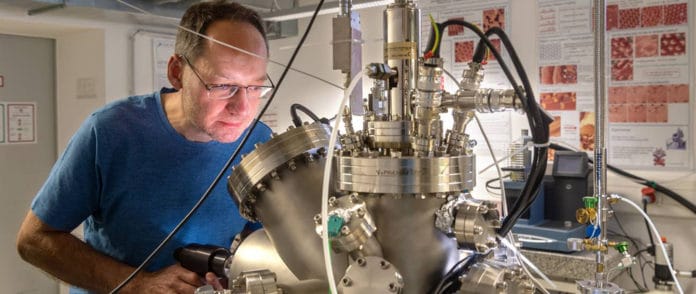The discovery of graphene has boosted up the hunt for new two-dimensional materials. Currently, two approaches are being used: the first one includes peeling off a continuous layer of molecules or atoms from the bulk of the material, and the other approach involves developing the material molecule-by-molecule by producing bonds between the molecules in various ways.
However, the materials are often small, fragile, and contain many defects. This limits the potential areas of application.
Scientists at the Technical University of Munich, the Deutsches Museum, and Linköping University, among others, have come up with a new efficient method to manufacture two-dimensional polymers. Their discovery leads to the development of new ultrathin functional materials with highly defined and regular crystalline structures.
The process of manufacturing polymers, i.e., polymerization, takes place in two steps. Scientists used a molecule called fantrip, a contraction of “fluorinated anthracene triptycene”- a merger of two different hydrocarbons – anthracene and triptycene.
Fantrip properties cause the molecules to spontaneously arrange themselves into a pattern when placed onto a graphite surface covered with an alkane. This process is known as “self-organization.”
In another process of photopolymerization, light is used to fix the pattern. A violet laser that illuminates the molecules excites the electrons in the outermost electron shell. This causes strong and durable covalent bonds to form between the molecules.
The resulting porous two-dimensional polymer is half a nanometre thick that has several molecules identically linked. In other words, the resulting material comes in nearly perfect order, right down to the atomic level.
As the photopolymerization is carried out on a surface of solid graphite, it is possible to use it on a molecular scale using scanning tunneling microscopy. This shows the newly formed bonds in a persistent network. To confirm the structure assignment, the research group led by Jonas Björk has simulated the appearance of the molecular networks under the microscope at different stages of the reaction.
Using high-performance computing resources at the National Supercomputer Centre in Linköping, scientists successfully validated the experiments and understood the key factors that make the method successful.
Jonas Björk said, “We see that the simulations agree well with real down to the tiniest detail, and we can also understand why our specific system gives such useful results. The next step of the research will be to see whether the method can link other molecules for new two-dimensional and functional materials. By improving the method, we will also be able to control and tailor the type of ultrathin materials we aim to manufacture.”
Markus Lackinger, research group leader at the Deutsches Museum and Technical University of Munich, said, “Creating covalent bonds between molecules requires a lot of energy. The most common way of supplying energy is to raise the temperature, but this also causes the molecules to start moving. So it won’t work with self-organized molecules since the pattern would blur. Using light to create covalent bonds preserves the pattern and fixes it precisely as we want it.”
“The most obvious application is to use the material as filter or membrane, but applications that we have no idea of at the moment in entirely different contexts may appear on the horizon, also by chance. This is why basic research is so exciting.”
Journal Reference:
- Lukas Grossmann, Benjamin T. King et al. On-surface photopolymerization of two-dimensional polymers ordered on the mesoscale. Nature Chemistry, June 3rd, 2021 – DOI: 10.1038/s41557-021-00709-y
